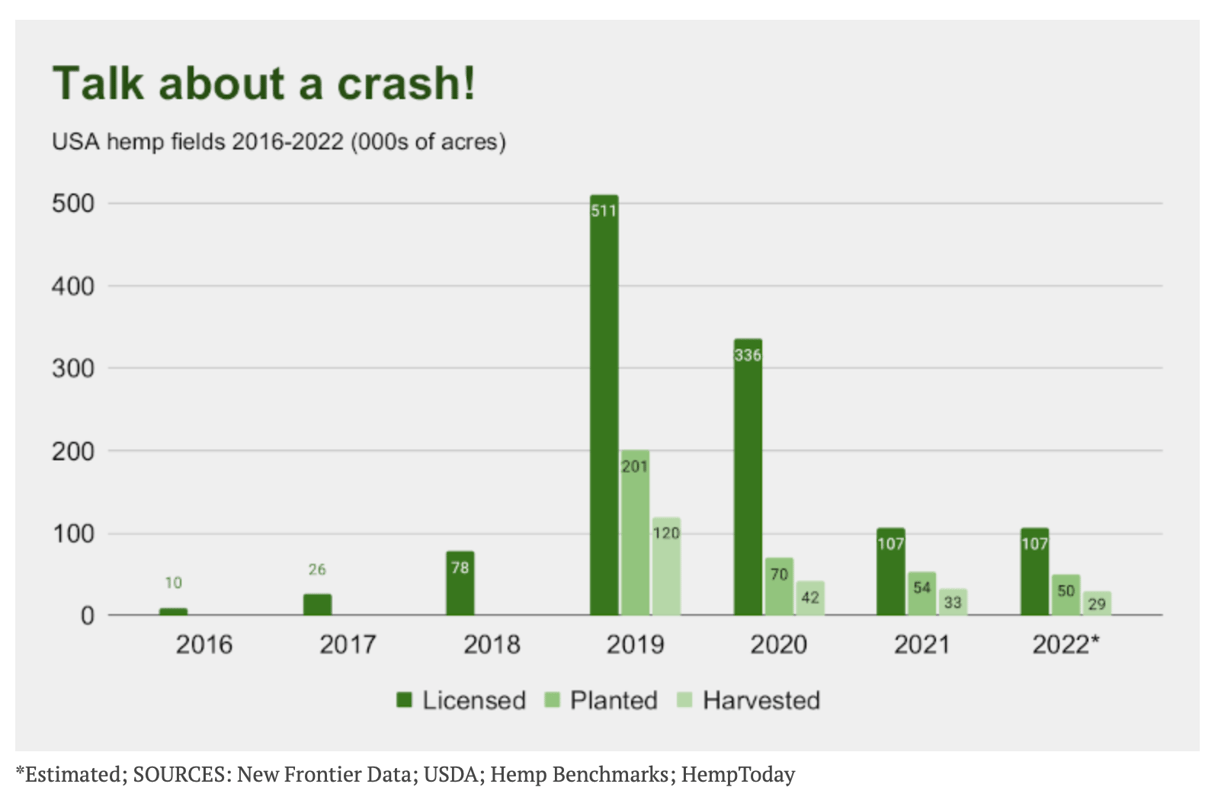From cash crop to CRASH crop> The hemp industry has declined by 80 percent over the last three years, according to a recent study released in the HempToday journal. In 2022, there were 107,000 acres licensed to grow Hemp in America. That number pales in comparison to the 511,000 acres licensed in 2019. It appears that tens of thousands of farmers planting hundreds of thousands of acres have overestimated the demand for hemp and its derivatives, such as CBD and CBG. Does this mean the green rush is over?

As an owner of a hemp seeds business, Fortuna Hemp, I have witnessed the downfall firsthand. Only about a third of the farms we’ve contracted out to produce our seeds still remain. Some are barely hanging on. The others have closed up shop, sold the farm, or were acquired. I get loads of emails every week asking if I know where to process tons of slowly deteriorating hemp into CBD.
With so much hemp floating around out there, you’ve seen a few things happen. The first thing to go was the price of a kilo of CBD isolate. Sliding from $ 10,000 to just a few hundred dollars. In an effort to stem the bleeding, farmers saved their best nugs and sold them as smokable hemp. Simultaneously, a push for more rare like CBG was all the rage.
Now things have gotten a little wacky. In a successful attempt of alchemy, CBD can now be converted into Delta-8. Oh, you didn’t know? Yes, the nugs you are smoking now could be hemp sprayed with D8. Ughh.
Apart from D8, why has the market collapsed? Mostly demand: People like cannabis because of its. Cannabis without a buzz is lame. If it weren’t, smokable hemp would have taken off without the help of Delta 8. Smokable hemp has no traction as the O’doules of cannabis.
Another reason for the regression is the quality of genetics VS the stiff regulations. With a strict limit, many crops tested hot and had to be wasted. Most CBD crops have to be harvested way before peak maturity. This limits the applications the hemp could be used in. Lastly, it’s the Processors. These are the people and labs responsible for turning Hemp into and terpenes. I once heard an investor remark on his apprehension of entering the processing industry, calling it “capital intensive.” It’s another way of saying the amount of money you have to spend to make any is outrageous. I mean, have you seen these places? The result was a lack of processors around the United States, leading to long delays in processing material and eventual bans of biomass testing less than 10 percent CBD. You couldn’t even get your hemp processed until it was “cleaned” of lower-containing material. What a heartbreak to hear at the end of a long season.
So what’s next? The optimist would point out that the FDA is on the verge of approving hemp and hemp derivatives in food and drink. Economists say that would double the size of the industry’s valuation from $5B to $11B by 2027. There’s also a federal bill introduced by Sen. Paul (R) of Kentucky that would bump the threshold to 1 percent from 0.3 percent. That’s great news. It feels like the bottom. So maybe it’s not a bad place to start. Only up from here, I suppose.
-Gu~

